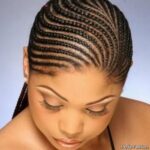Hair Extensions Tips – A Complete Guide
Below you will find professional hair extensions tips, from our experienced hair stylists to learn everything you need about extensions!
Which System ?
Trying hair extensions for the first time may be confusing. You will find that different salons offer you different solutions. We have provided you with a comprehensive overview of different methods of extension application and useful hair extensions tips to help you decide which may be best for you. So, is it Thermal Bonding, Micro Ring, Cold Bonding, Braiding, Weaving or a Quick Fix you desire? Read on to find out!
Where do I begin?
When you visit your salon, you should find out which system(s) they use to attach extensions and also whether they work with human or fibre extensions. Prior to booking your appointment for your new extensions, your salon should offer you a consultation which will help determine the type of extensions most suitable for you. It is important for hair extensions tips in every salon you go, so you are as informed as possible. You can conduct a search for salons that offer extension services on this website. Once you are completely happy and confident go ahead and book your appointment to have your hair extensions fitted.
Learn about different techniques
Before we get to the actual topic of application, its important for one to know about the utility of the technique as well. This is a technique of adding hair to your own hair by means of fusion (strand by strand), weaving, braiding or bonding. There are many variations to all of these techniques and stylists call these by different names. We call extensions clip-ins too. A stylist is the one that usually applies extensions but many customers are doing this. There are many types of hair extensions available on the market today and we are sure to see many more systems in the future. Hair extensions are thankfully here to stay. We can all have it now! The look we want when we want it.
Do you need more hair extensions tips? Keep reading, we have many more!
D.I.Y / Clip ins
Clips have been sewn onto human extensions hair. You may clip these in and out yourself. Clip in hair extensions are very easy to use, even at home! The clip in hair extensions does not require the use of glue and are relatively safer for your original hair. Your hair stylist can create lovely clips in hair extensions, curled or straightened!
Sew on Weaving
A technique which is used to add length and volume by applying extension wefts to the client’s natural hair. This technique is not noticeable as the natural hair is braided underneath and it is not visible. Weaving is a safe technique that does no damage to the client’s own hair, instead protecting it and allowing natural hair growth to continue. A band of fine threads are holding together wefted hair extensions. Wefted hair comes in two types, machine wefted and hand tied. Due to the high cost of hand made products, most extension hair is machine wefted in fine, medium or heavy wefts. The majority of wefted extension hair are using medium wefts. Many customers prefer hand tied wefted hair, even if it is more expensive, due to its light weight.. Hand tied hair also resist shedding better.
Wefted hair: more details
Strand bonding and braiding often use wefted hair. Stylists are often using this technique because it is reducing the amount of waste.
As BULK we identify hair without a heft.
Whilst a full head of weaving is often popular, clients may choose to add only a few rows of weft depending on the desired style.
There are several methods of attaching weaves. The original method, is by cornrowing the entire natural hair or leaving the hairline and nape of the neck loose to cover the weft. After assessing the client’s needs though consultation, together with your stylist you are going to choose the appropriate method of weaving.
This is a process, which you create a cornrow or track around the head and close to the scalp. Extension hair is sewn on the tracks. Your own hair lies over the tracks for a natural look.
Tracking or Micro-Weaving
Positions small tracks of hair on the scalp in rows and the stylist weaves threads in a lock stitch application. Tracks of hair or woven near the scalp to provide support for the extensions. Tiny weaving thread is used to weave in the extensions. Although tracking looks good, make sure your stylist knows the technique for applying sew in hair extensions because improperly attached, the extensions can damage the scalp. And as we said before, always ask for hair extensions tips to any salon you visit before the stylist apply and technique!
Fusion or Strand by Strand
This is a process done strand by strand in small sections. Using heated adhesive sticks made for extensions placed in a glue gun. Your hair lies over the top for a natural look.This method is arguably the best, though the type of adhesive used is critical. Wax-based adhesives have a low melting point so a professional grade adhesive is a must. These adhesives can withstand both heat and chemical treatments. The adhesive remover that is used to remove the hair extensions dries the bonding agent to a powdery substance (rather than dissolving it through messy oil and heat). If interested in hair extensions speak to 2 or 3 professionals about your specific needs and concerns and get a written estimate of what they would do and how much it would cost. New methods will no doubt come to light and it’s always wise to get more than one opinion regarding hair extensions tips before committing to something that will represent a substantial investment of time and money.
Weft Hair Extensions
Hold together through a network of tiny threads. The weft looks like a flow of hair flowing from the top. Yout hair stylist is attaching weft hair extensions to your head by sewing them into a tiny braid made out of your own hair. The effects achieved with this technique are very natural and appear as seamless human hair extensions. No one can see the braids or wefts of hair unless you show them. Weft hair extensions hold together through a network of tiny threads. The weft looks like a flow of hair flowing from the top. Stylists attaching weft hair extensions to your head by sewing them into a tiny braid made out of your own hair. The effects achieved with this technique are very natural and appear as seamless human hair extensions. No one can see the braids or wefts of hair unless you show them.
Bonding
This is the easiest method. Hair stylists are bonding glue onto the weft of the extension hair and then at the root of your hair. This is a temporary method. The extensions used for this method have a latex plug meant to be glued to your own hair for short terms use. Because this method is fast it’s also inexpensive. However, to remove extensions, oil and heat must be used to dissolve the bonding agent, which messy and time consuming. If not removed with care the latex can pull your own hair out.
Bonding is when bulk or wefted hair extensions is applied by using hair bonding agent or pre-bonded tips. In this case, a special adhesive is created to help in hair bonding. Such hair extensions are glued to the tiny strands of hair. Some lovely hair extensions already have adhesive on each and every section of the hair. The difference in the two would be the amount of time you can save in gluing these hair extensions to your original hair. Hair stylists using many methods for this process, such as thermal bonding, liquid bonding and adhesive bonding. Here, the adhesives differ and also the methods used for their application. Please see below for more detailed hair extensions tips and methods.
Adhesive Bonding
Bonded hair additions use specially formulated adhesives to attach the hair. Adhesive bonding products are usually wax based
or Keratin based. The Keratin based products are harder and come in medium or hard hold. The wax based product (Fusion) come in regular hold (Pro Fusion) and in medium hard hold (French Fusion). Fusion adhesives do not require acetone to remover and tend to be easier on the hair. With proper care, the French Fusion product can hold up to 3 months. Keratin adhesives are harder and can last up to 6 months.
Liquid Bonding / Cold Bonding
Cold Bonding is a simple process that takes 30 to 60 minutes to attach depending on the amount of hair. The hair stylist is applying a cold resin to the top of the hair wefts that are then placing them onto the natural hair close to but NOT touching the scalp. It is a temporary attachment method, which lasts up to a week, or until your next hair wash. Stylists are attaching wefts of hair flat and close to the natural hair line, using a cold resin, providing a smooth and comfortable finish. Cold Bonding is a less time consuming method of attaching hair, therefore less costly also, and is ideal for those that want to add extensions for a short period or special occasion. Necessary is a patch test during your consultation, to check that you have no allergic reaction to the cold resin.
Before the hair stylist add the extensions, washes and dries client’s hair. At this stage, hair stylist is not using any conditioners or oil based products, particularly close to the scalp lines.
Thermal Bonding / Fusion Bonding
The fusion bonding method is the most common method of attaching hair extensions, it is also the quickest and easiest way to fit hair extensions.Stylists are cutting small sections of Remy human hair for the weft applying a small amount of warm keratian bond around the strand with keratin gun. Then, the hair stylist is placing these small sections of your own hair and rolling them with a silicon pad. It is, often referred to as ‘micro-bonding’, is a popular method of applying extension hair to clients of European or Caucasian origin. This method attaches a few strands of hair at a time to the natural hair, close to the scalp but not touching it, using a special hot resin formula. Stylists are using it to add highlights strands and increase volume and length. The benefits of bonding are that it allows clients to run their fingers straight through giving an effect of ‘free flowing’ hair. Most hair styles are suitable for thermal bonding, excluding extremely thick, course or brittle hair.
For more hair extensions tips check this too or just give us a call at (416) 566-7269!

